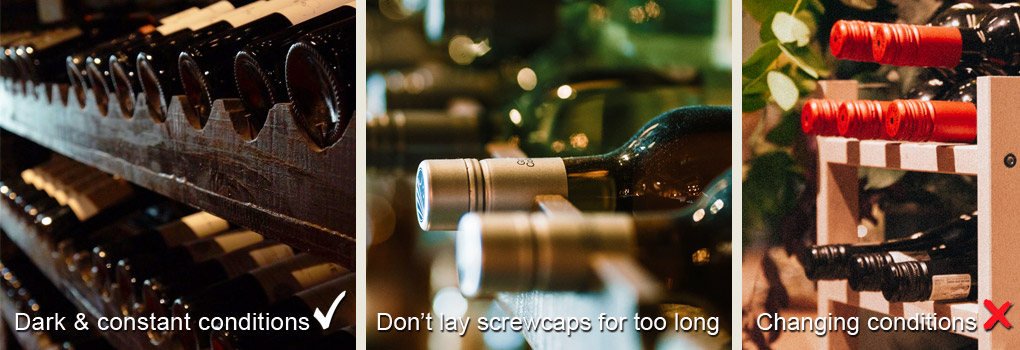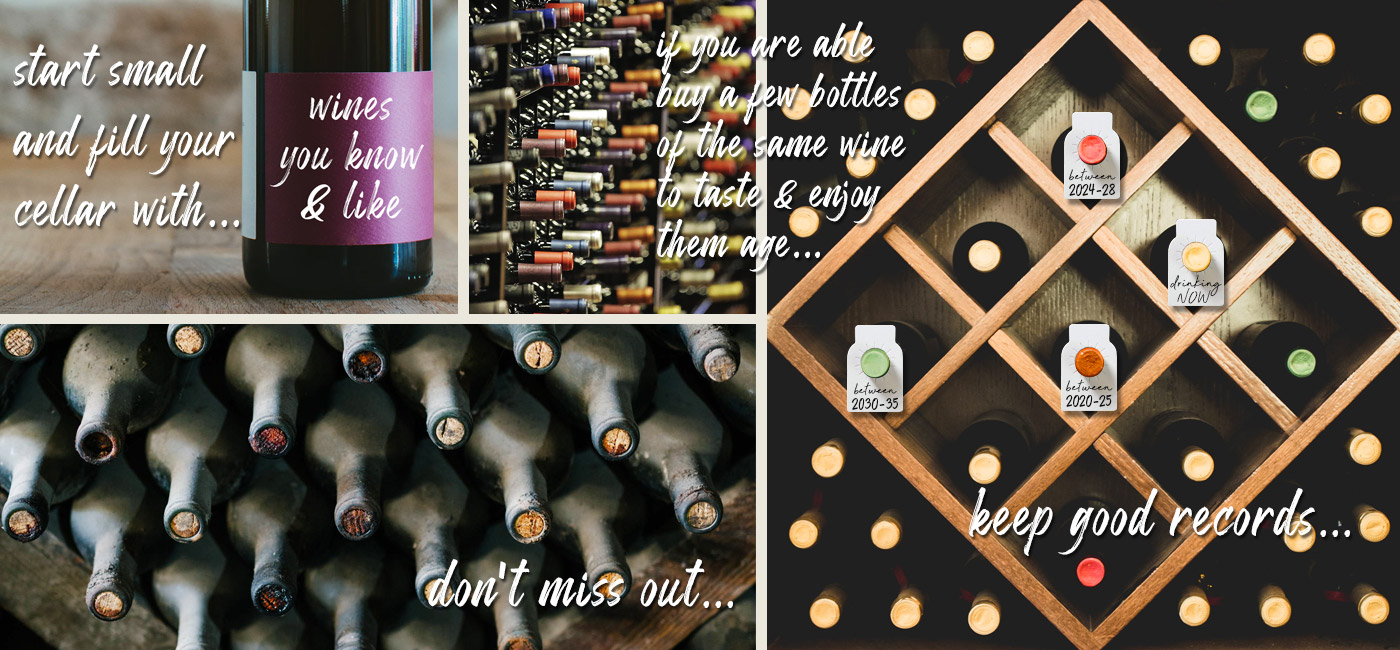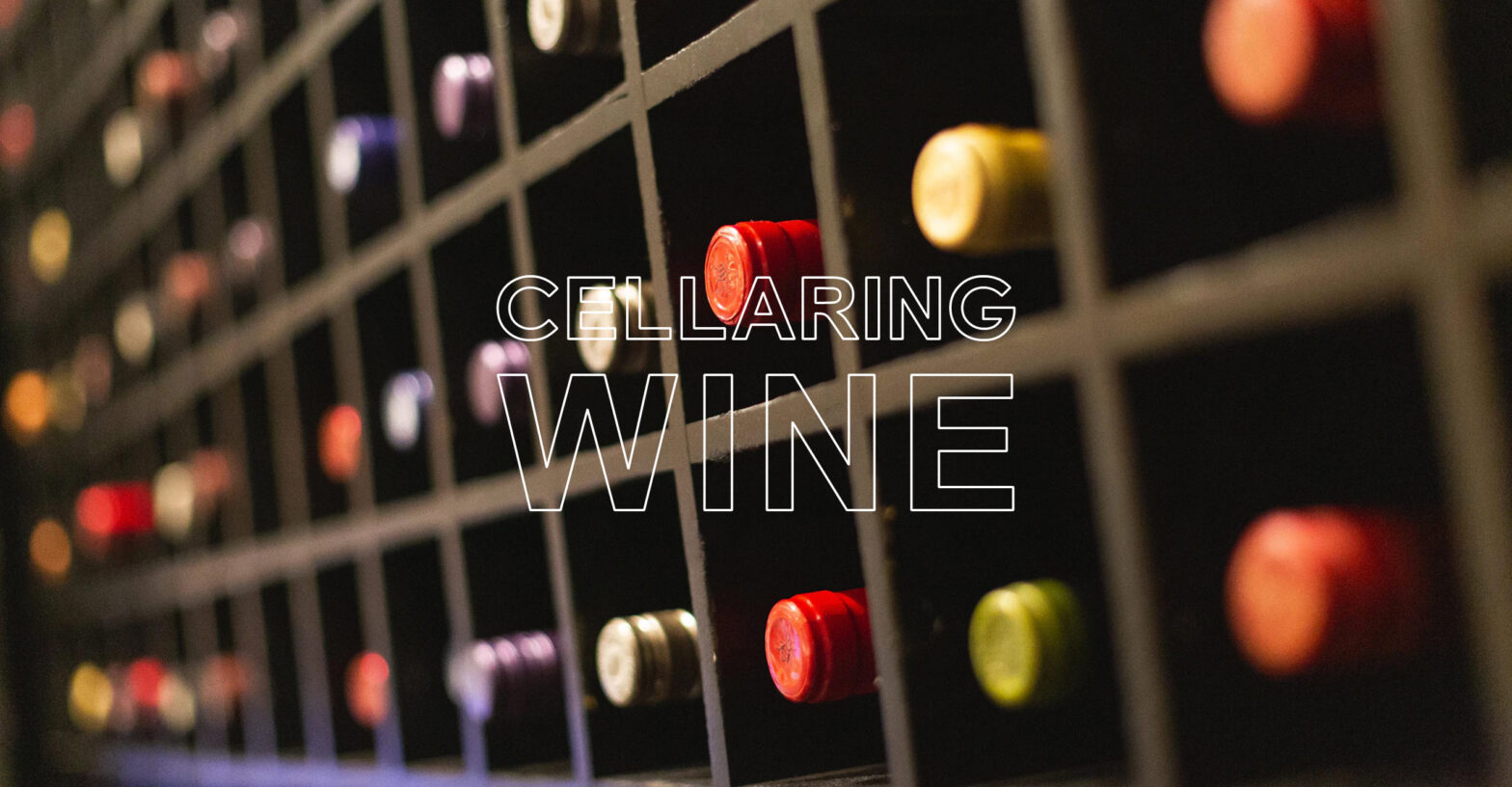‘Your Wine Cellar’ might be an underground cellar filled with expensive rarities, or a number of favourite bottles stacked in the cupboard of the spare bedroom or a few bottles kept on a rack in the kitchen. In either case, there are certain requirements for maintaining wine in good condition that you should know. In modern, well insulated & heated homes, some of these conditions are hard to find, though this is only really a problem if you have wines you intend to keep for the medium to long term - say 3 to 10 years or more.
The wines shown in the below photo (bottom left) are lying in a specifically designed wine cellar at a cool 13°-15°Celsius, having no wild fluctuations in temperature, are dark and are free from vibrations; in addition, it has controlled humidity. Humidity is a critical, yet often overlooked feature in wine cellar design. The relative humidity should be between 50% - 70%, with 60% the ideal. Without ideal humidity, wine quality may be affected. As when the humidity is higher than 70%, it is likely to cause unwanted mold to form on the bottles, labels and cork. When the humidity is below 50%, corks will begin to dry out resulting in loss of wine in the bottles and eventual degradation. These are the ideal conditions for cellaring wines long term; modern homes can be rather unfriendly places in which to age, cellar wine - long term (i.e. more than 2 years).
Wine bottles with corks should be placed horizontally, this is vital for all wines with a cork closure that are being stored for more than 6 months. This means that the cork is kept in contact with the wine, preventing it from drying out. If they are stored upright (which you can and should do with screw-caps - as laying them down for too long, there will eventually leak), the cork will eventually shrink, allowing air to enter and spoil the wine.
A constant temperature *(ideally only the slightest fluctuation in a 24 hour period, no more than 2°celsius) is far more important than absolute coolness. Ideally, an unheated cupboard where the central heating will not be constantly raising and lowering the temperature. Ideally keep the temperature down below 17°C at home. Though preferably between 13°C - 15°C as at these temperatures the wine is 'not too cold' to still mature as intended and 'not too warm' to age too fast.
Garages and tin sheds are not a good idea, as they freeze in winter and over-heat in summer. Dark conditions will avoid the wine's colour being spoiled, again a cupboard might be a good choice, but in any event try to ensure the wine is not in direct sunlight. Storing, keeping the wine in the box it came in is always a good idea if you have more simple storage conditions. Freedom from vibration is also important, as constant agitation does not give the wine time to mature slowly. Do not position your wine rack next to the washing machine or spin-dryer or next to the oven or near the kitchen window in direct sunlight - as direct sunlight will damage a wine within hours.
Strong smells can taint wine over long periods of storage - another reason why the kitchen or garage/ toolshed are not the ideal location. Finally - keep a journal of all your wines, so you know what you have and when best to enjoy and share them. Do all that you can to keep your wine-log up-to-date, as the last thing you want is to find a favourite wine in years to come past its best. Not only would it be a loss of money, but missing an opportunity to share a special wine, occasion with good food and friends.

The Colour of Wine:
The primary ‘colour of wine’ comes from the skin of the grapes. The juice that comes from nearly every variety of wine grape when pressed is clear or pale in colour. This is true of the juice pressed from red wine grape varietals as it is for white grapes.
The colour or pigmentation of red grapes are found in the skins of the grapes. In order to make a red wine from red grapes, it is necessary to leave the skins in contact with the juice during the fermentation process. When the skins are placed, left in the fermenting 'must' (which gets up to a heat between 21°- 30°C), the pigments leech out of the red grape skins and colour the wine. When red grapes are immediately pressed off and the skins are kept/ taken out, the colour of the wine remains white and is considered a 'Blanc de Noirs' - a white wine made from red skin grapes; (e.g. Champagne).
White wines do not usually have the skins left in the 'must' during fermentation. If the wine is being made from white grapes, there is no benefit to the colour and if the wine is being made from red grapes, the skin contact would give an undesirable red colour to the wine.
Rosé wines can be made with a 'limited/short' skin contact (leaving the skins in the fermenting juice for only a short period of time) - this method can be unreliable in obtaining consistent tinting from tank to tank, so blending is required before bottling. Some Rosé wines around the - specifically method rosé wines can be made by adding a specific amount of red wine to the white wine before the secondary fermentation.
Why is the 'colour of a wine' so important to inspect? The colour of a bottle of wine with respect to its varietal or age can be an important clue in determining if a wine has been made in a classic style, if it is a light or fuller style, potentially aged in oak, or if the wine has aged well over time.
• For example, if a one year old bottle of Sauvignon Blanc is clear and bright with a shining hue in the glass, you can deduce the wine is youthful, light in style and with a fresh character. Though it the same wine style is a golden colour with a soft hue when the bottle is opened, this could signify the wine has been aged for several years (it might have been aged in oak) and will have a different expression. Or that the closure was faulty causing the wine to age prematurely *(oxidize) and may not taste at its best.
• The same can be said for red wines: for example, if a Merlot or Pinot Noir is poured into a glass and it has a brick red colour edge or a deep brown core colour, chances are that the wine has been aged for several years or if it is a recent vintage, there could be a problem with the bottle closure, or the temperature of the cellaring conditions or possibly exposure to direct sunlight - and it too will not be at its best.

How to start a wine collection:
Many of you have heard about legendary wines opened years after they were bottled and described as having entered a state beyond description, expressing what can only be called as sublime - a sensory experience of a life-time.
Not all wines become mythical after years of ageing. On more than a few occasions I have had friends open old wine, and instead of being elegant, integrated and balanced - they are tired and bitter. Recently a friend opened a 2001 Rosé - this style of wine is made in a quick method and is at its best in the same year and on occasion a few years later - but not 18 years later. We tasted it, and yes it had reached the vinegar stage. Keeping a wine too long is one problem, but a more common issue is opening a wine too soon.
Sometimes this can be linked to not being informed by the retailer of its style, quality and ageing potential. Last week a friend opened an expensive 2018 bottle of Pinot Noir - the fruit was shy and tightly wound, it needed a number of years before the wine would develop into the expressive, delicious characters people love about quality Pinot Noir.
Wine is a living and breathing thing, and like a person it goes through stages of adolescence, maturity, old age and tired-fragility. Some wines reach maturity quickly while others are more intense, highly structured and need a decade or more for each orchestral member to play seamlessly together in harmony. Drinking wines which are slightly young can still be enjoyable, but with experience you will realise that they had potential to be so much more.
Today more and more from every wine producing region and winery the world over - wines are being crafted which can be enjoyed in their youth or as soon as they reach the retail shelf or wine-list. This is for a number of reasons - but it benefits those without patience, and the ability to purchase wines and share them straight away. For Restaurants - it would be no good for business if the wine-waiter asked you to come back in 10 years when the wine you have chosen will be at its best.
Many of the wines available in supermarkets and wine retailers are designed for early consumption. And many people use retailers as their wine cellar - buying wine as and when they need for each occasion.
A prime example is Sauvignon Blanc & Rosé - which on release can to be enjoyed as soon as you turn the clocks forward for summer. Fruit forward red wines with soft tannins and light (even no) oak, from around the world typically are at their best within 2-3 years. Plus - they simply don’t have the structure to help them age for a long time.
There are many variables used to determine a wine’s ageing potential; including the vintage (growing season), varietal, fruit quality and winemaking techniques used. But sometimes it is difficult to determine a wine’s future potential without tasting a sample shortly after the wine is bottled. That is why cellar-door, in-store and wine club tastings are so helpful.
Young wines which tend to age well, display pronounced tannins, expressive acidity or high levels of residual sugar (dessert wines), all of which are natural preservatives. Big red wines, such as Cabernet Sauvignon have good aging potential because of their natural bold tannins. Quality Chardonnay makes up for its lack of tannins with high acidity levels. While, dessert wines like Sauternes contain high amounts of natural residual sugar which helps them age gracefully. But these wines also require expressive fruit and a firm structure that will last the distance until the tannins and acidity soften.
Until you start to become more serious about collecting wine or start purchasing bottles priced over NZ$30 don’t worry too much about trying to age the wines you purchase. But if you are looking to start a wine collection with age-worthy wines.
First - find out for certain what styles of wine you like and regularly enjoy. By asking a few questions - (more than just price and colour…) - you can start buying wines that can age and give you an experience which a recently, bottled youthful wine (like a teenager adding to a conversation, compared with a well-travelled, older person sharing experiences) - an aged wine will express something richer in depth and character.
If the retailer does not have staff to talk with about the wine - before purchasing visit the winery website and look for detailed tasting notes from the winemaker as a guide. Or better still, follow a website like this one, which gives you more insight into each wine review.
So you find that outstanding wine *(remember you are buying for your taste-buds, as hopefully you get to enjoy the wine) - at a friend’s dinner or a local café-restaurant, and you hunt and find some in a wine store. Then the decision how many bottles to buy. My rule of thumb: if it is a current vintage (i.e. good availability) and it was served with a specific dish and you don’t cook much - buy 2 bottles and put them away for a rainy day - special dinner guests. If you really like it now (and it was hard to find) and you can see yourself enjoying it on several occasions during the year (and if your budget allows) buy 3 - 6 bottles.
But - if you really like the potential in the wine (i.e. you are getting serious about cellaring wine - and can see it improving each year for another 10+ years) - and buying a whole case, possibly en-primeur - can get you a discount, or more importantly a guarantee supply of a wine you really like. Then again if your budget allows, buy 6 - 12 bottles. But now you will need to start a Wine Log - (plus update your home-contents insurance) so you know what you have in your collection. Write things down - and store somewhere safe (though easy to access) so you won’t lose the information. Sure transfer it to a Word or Excel spread-sheet, and save it to your computer, tablet or mobile phone.
A well-documented Wine Log will help ensure that you can find the perfect wine and vintage in quick time for the right occasion. Your Wine Log should be what works best for you. Here are a few simple ways to catalogue your wine collection.
• Style: If your collection is relatively small and you are not too particular about grape varietals, try organizing it simply by: sparkling, whites, reds and dessert-fortified wines.
• Varietal: After allocating one shelf or row each for sparkling, whites, reds and dessert-fortified wines. Look to group the same varietals together so that your Shiraz wines are not mixed in with your Cabernet’s and so forth.
• Region & Varietal: If your wine collection is getting a little more substantial, it might be time to add region and varietal to your wine-log / filing system. A Chardonnay from Chablis, France should not be in the same box or the same shelf as a barrel fermented Chardonnay from Hawke’s Bay, NZ - if your collection is to be sorted for easy access.
• Drinking Window: If your collection is large enough to comprise a number of aging wines, then you might want to further classify your wines to include a drinking window *(start drinking date and a potential peak date). So that you can ensure that you are opening your bottles at their most interesting and peak period. And not past their best.
But just as you diligently add to your cellar and Wine Log - update and remove wines - as you will be disappointed after hunting for that special wine that you drank last Xmas. Most importantly - enjoy the journey.

As Wine Ages...
Wine, like any fresh food, changes with time. But whereas most consumables deteriorate from the moment we buy them, wine is one of the very few things we purchase that has the capacity to develop, and even change for the better.
Perhaps the top 10% of all red wines and 5% of all white wines (it must be noted that these are generous estimates) will be more pleasurable, complex, harmonious and more interesting to drink when they are three-five years old - than at one year old.
The top 1% of all wine made has the ability to improve for a decade or two or, in some cases more. The great majority of all wine, however, will actually start to lose the fruit flavours and varietal characteristics that give its youthful appeal within the first 12-18 months of being bottled.
The more fruit flavours, acidity, phenolics, oak and tannins found in red wines, that go into a bottle of wine at the beginning, the more opportunity for complex interactions between all of these compounds and the more rewarding it can be to age. This can simply mean, the more intensity and depth of character, the more likely it is that the resulting wine will appreciate and repay cellaring.
Tannins and colouring compounds known as anthocyanins are the most obvious types of phenolics which preserves red wine as these interactions occur. These and other compounds continue to interact, forming bigger and bigger complex compounds which after a few years are too big to remain in solution and are precipitated out as sediment.
So as a good quality, concentrated red wine ages it becomes paler and softer to the taste, while gaining considerably in the range of flavours it presents (which by now constitute a bouquet rather than simple aromas).
Any red wine with visible sediment (a fine deposit on the side or bottom of the bottle) is likely to have completed quite a bit of its development, ageing process.
Even less is known about how white wine ages, although acidity is thought to be the preservative white counterpart to that of tannin. Certainly, the longest-lived white wines are those with good extract but good levels of acidity. The fact that white wines have far fewer phenolics explains why fewer of them can last as long in bottle (although 'botrytis' can preserve some sweet white wines for decades and selective Tokaji wines even longer).

